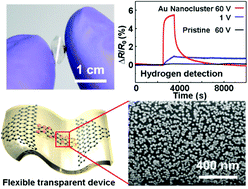Au decoration of a graphene microchannel for self-activated chemoresistive flexible gas sensors with substantially enhanced response to hydrogen†
Abstract
Graphene is one of the most promising materials for high-performance gas sensors due to its unique properties such as high sensitivity at room temperature, transparency, and flexibility. However, the low selectivity and irreversible behavior of graphene-based gas sensors are major problems. Here, we present unprecedented room temperature hydrogen detection by Au nanoclusters supported on self-activated graphene. Compared to pristine graphene sensors, the Au-decorated graphene sensors exhibit highly improved gas-sensing properties upon exposure to various gases. In particular, an unexpected substantial enhancement in H2 detection is found, which has never been reported for Au decoration on any type of chemoresistive material. Density functional theory calculations reveal that Au nanoclusters on graphene contribute to the adsorption of H atoms, whereas the surfaces of Au and graphene do not bind with H atoms individually. The discovery of such a new functionality in the existing material platform holds the key to diverse research areas based on metal nanocluster/graphene heterostructures.



 Please wait while we load your content...
Please wait while we load your content...